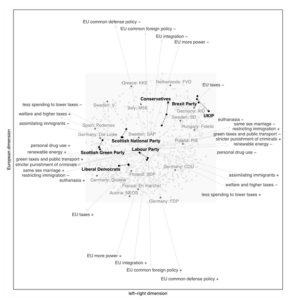SNP: National But Not Quite Pro-European
Elections in Scotland last week were declared by the winning Scottish National Party, which secured the fourth victory in a row, as a historic. Even though one seat short of an absolute majority, together with the Scottish Greens the two pro-independence parties have a comfortable majority in the Scottish parliament. This win was expected and instead of resolving anything, it is the beginning of the next chapter in Scotland’s strive for independence, a chapter in which not only the push away from the United Kingdom comes into play, but also the pull of the European Union. The following overview will zoom in on the latter by analysing how the pro-independence parties are located in the overall European political space.
Even though Scotland ultimately lacks sovereignty as part of the United Kingdom, the devolution at the end of the 1990s, which saw the establishment of the Scottish parliament, gave the region quite wide-ranging autonomy in governance, among other things in such matters as healthcare and taxation. The main question of the Scottish parliament elections on May 6th, however, was not about day-to-day matters of local politics, but something far more existential and with potentially far-reaching consequences. The election was about Scottish independence and its relationship to Europe.
Although the independence referendum in Scotland that took place in 2014 was supposed to be a once in a generation event, a new referendum has been on the agenda mostly because Brexit took Scotland out of the EU against their will. In the 2014 independence referendum, a clear majority preferred to remain in the UK. In the Brexit referendum, however, almost 2/3 of the Scots voted to remain part of the European Union. This has created a situation ripe for the pro-independence parties in Scotland as they can use Brexit to further their cause for Scottish independence. Thus, at least for the time being, the question of Scottish independence and the question of EU membership have become intertwined.
In this context it would be informative to have a look at the broader picture of where the pro-independence Scottish parties (Scottish National Party and Scottish Greens) stand on EU related matters as well as in the general European political space and how they compare to the unionist parties in the Scottish elections (the Conservative Party, the Labour Party and the Liberal Democrats).
We can get a fairly good sense of not only the political space of the UK, but of the entire Europe using the data that has been generated for the EU Profiler / EU and I voting advice application (VAA) for European Parliament elections. The VAAs from 2009, 2014 and 2019 have contained a set of recurring questions on social, economic as well as Europe-related matters and these allow us to position parties in a common European political space over time. The whole data set contains more than 700 parties over three EP elections, including all the main parties in the UK and Scotland.
In order to analyse this political space, first the differences between all pairs of parties were calculated using city-block distance. Multidimensional scaling was used on the resulting matrix of pairwise differences to create a lower-dimensional representation of this party difference space. A two-dimensional representation, while obviously not perfect, gives a satisfactory representation of the underlying party differences.
The following figure indicates the location of all parties in Europe as well as the UK and Scottish parties in that space over the three observed EP elections. The horizontal dimension in the depicted space broadly corresponds to a general left-right dimension and the vertical dimension to the European dimension (pro-EU is down and anti-EU is up). One can make sense of this space by looking at the locations of some key parties in it. For this purpose I have shown, in addition to the UK parties (the line indicates their position across the three elections), parties from various other European countries.
Furthermore, I have indicated the directions of the 15 specific questions in this underlying space that were used to differentiate between the parties together with their polarity – one end of the line indicates a positive position and the other end a negative position on the mentioned issue. One can see that left-right social and economic issues broadly align horizontally and European matters align vertically. The more a party stands out in the direction of a particular issue, the more these issues differentiate that party from the rest.

Image: UK parties in the European political space (source: author)
First of all, we can see clearly from this analysis how the unionist camp is divided in both left-right and European matters. The Conservatives have since 2009 become much more Eurosceptic and are now in the territory occupied by UKIP and the Brexit Party, as well as AFD from Germany and Forum for Democracy from the Netherlands. The Liberal Democrats as well as the Labour Party are clearly in the pro-EU territory. The Labour is more towards the centre of this political map and the LibDems more pro-EU, but still not as pro-EU as the German Greens, Austrian NEOS or the German Free Democrats, which are among some of the most pro-EU parties in Europe (i.e. supportive of the strengthening and federalisation of the EU).
Where do the Scottish pro-independence parties – the SNP and the Scottish Greens – stand in this picture? They are quite close together. On the LibDems – Conservatives axis they are clearly towards the pro-European side, but not as pro-European as the Labour or the Liberal Democrats. Indeed, in the grand scheme of things (regarding issues other than EU taxation) one could say that their attitudes towards EU and further EU integration are rather centrist and they do not stand out as particularly pro-European. To put this into perspective, in some sense they are on the same level as the Law and Justice from Poland. Where the pro-independence parties do differentiate themselves, however, is with regard to socio-economic matters, where both are distinctly left-liberal, occupying the same territory as for example Die Linke from Germany. The Scottish National Party is thus an interesting combination of both nationalism and socialist-leaning economic policy.
Being forced out of the EU against their will probably does have a unifying effect for the Scottish pro-independence parties, but perhaps the unifying or driving factor of the EU should not be overemphasised. European matters, at least until 2019, were not the issues on which these parties stood out the most, although for sure these were also not issues that divided them. It seems that the pro-independence parties do not want a stronger EU, for them this is simply a convenient tool to further their cause of independence. Perhaps what is more important is that the unionist camp is ideologically extremely split, spanning both dimensions that constituted this particular political space.
Author: Martin Mölder






